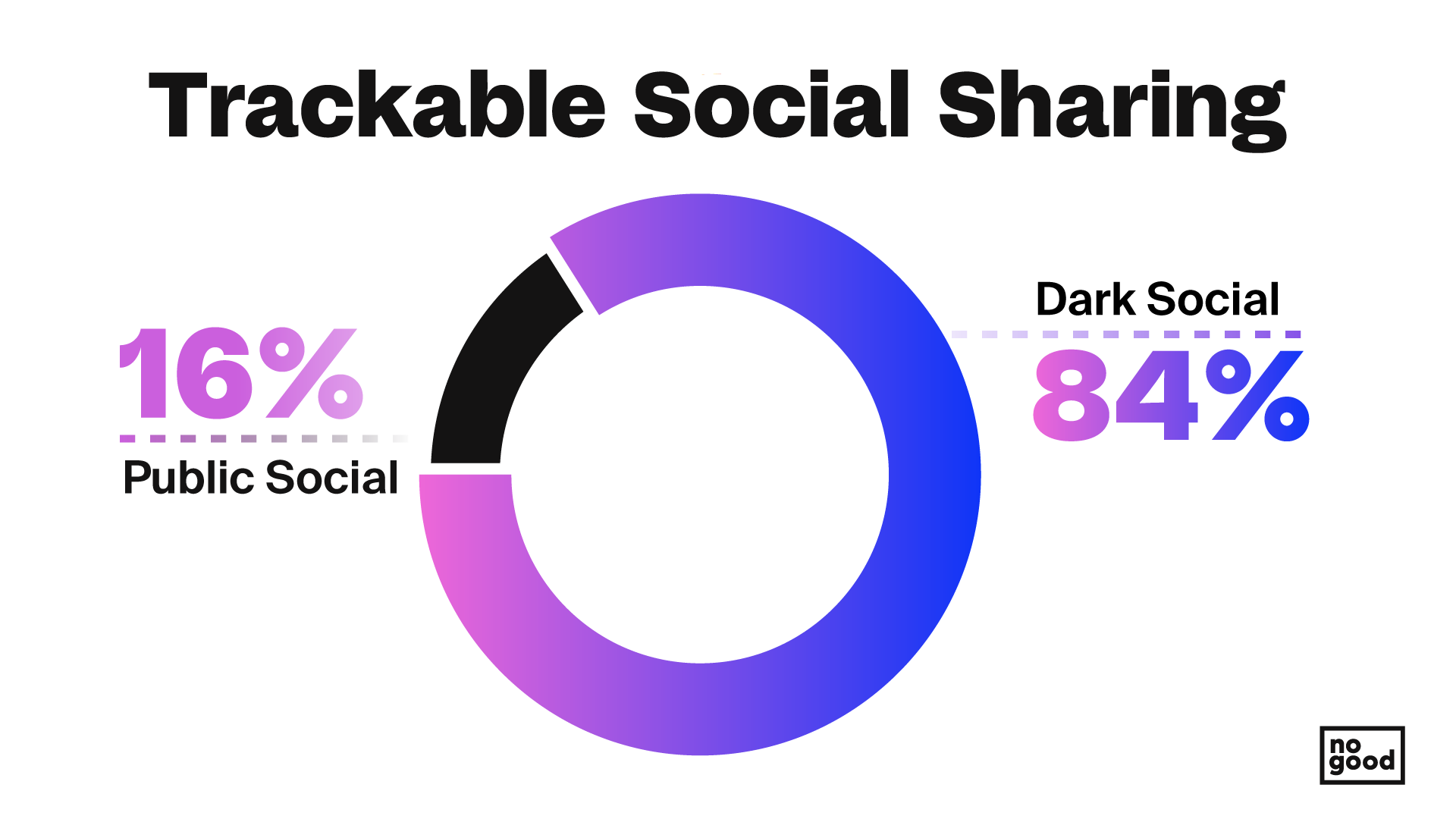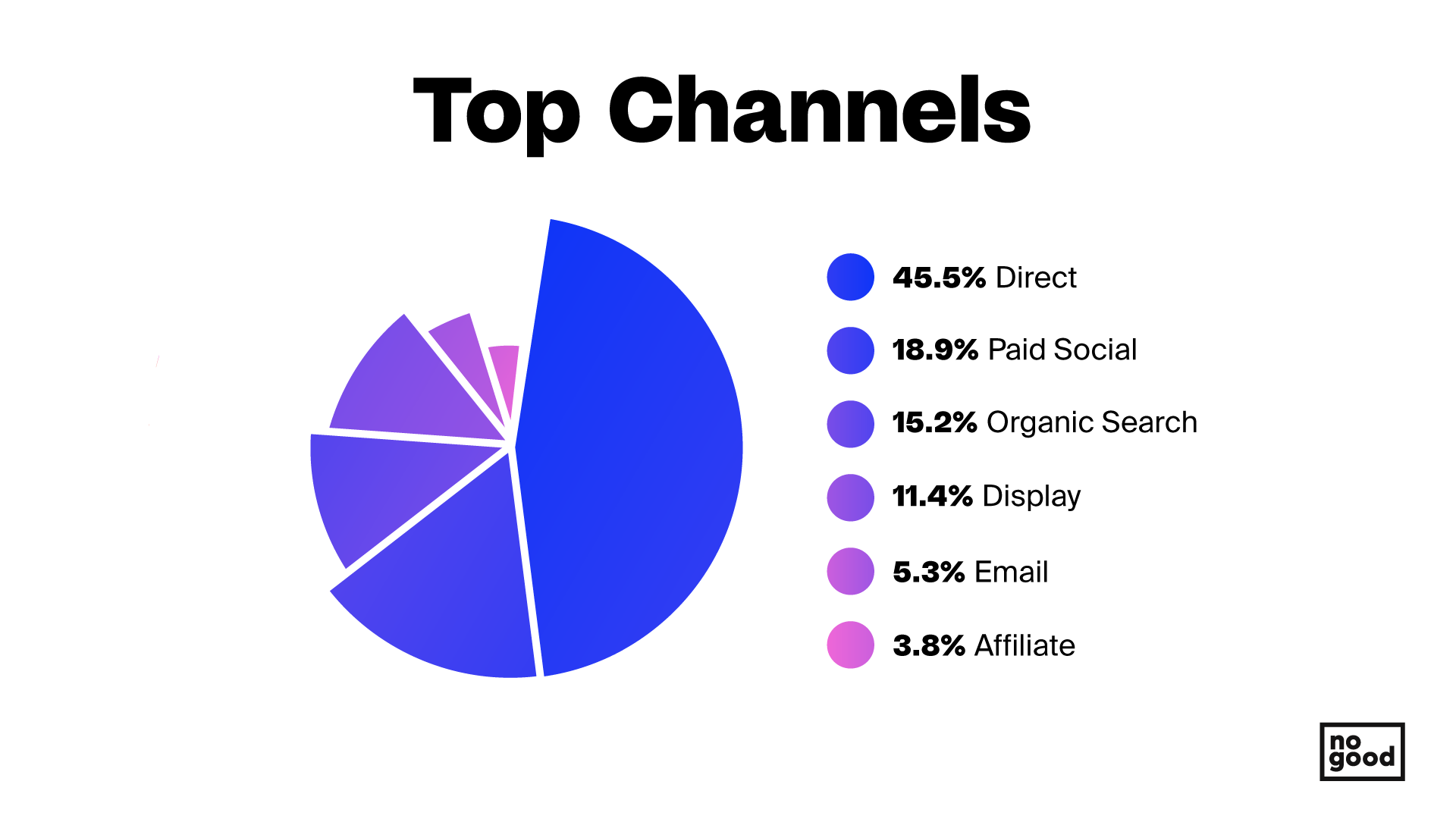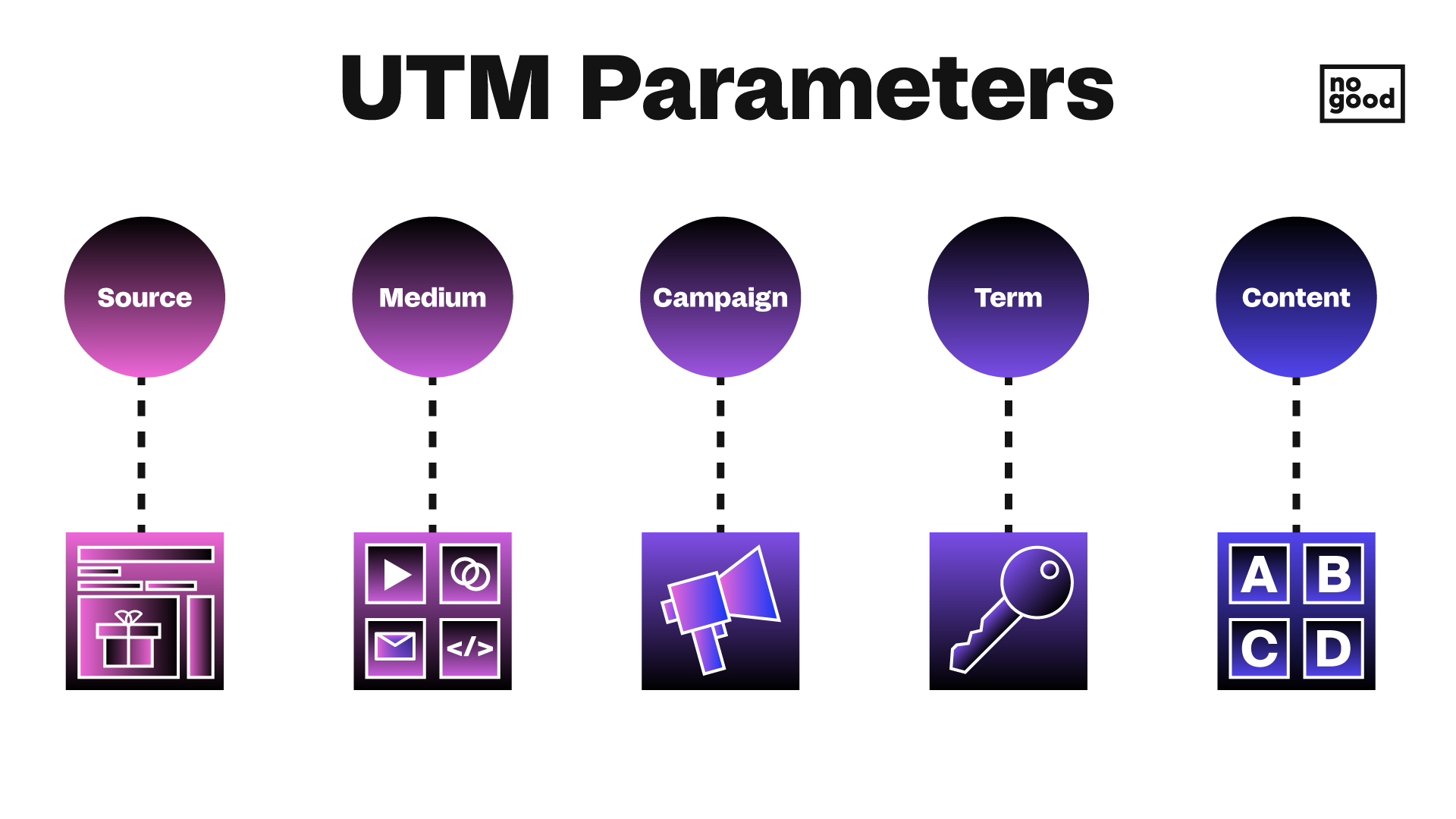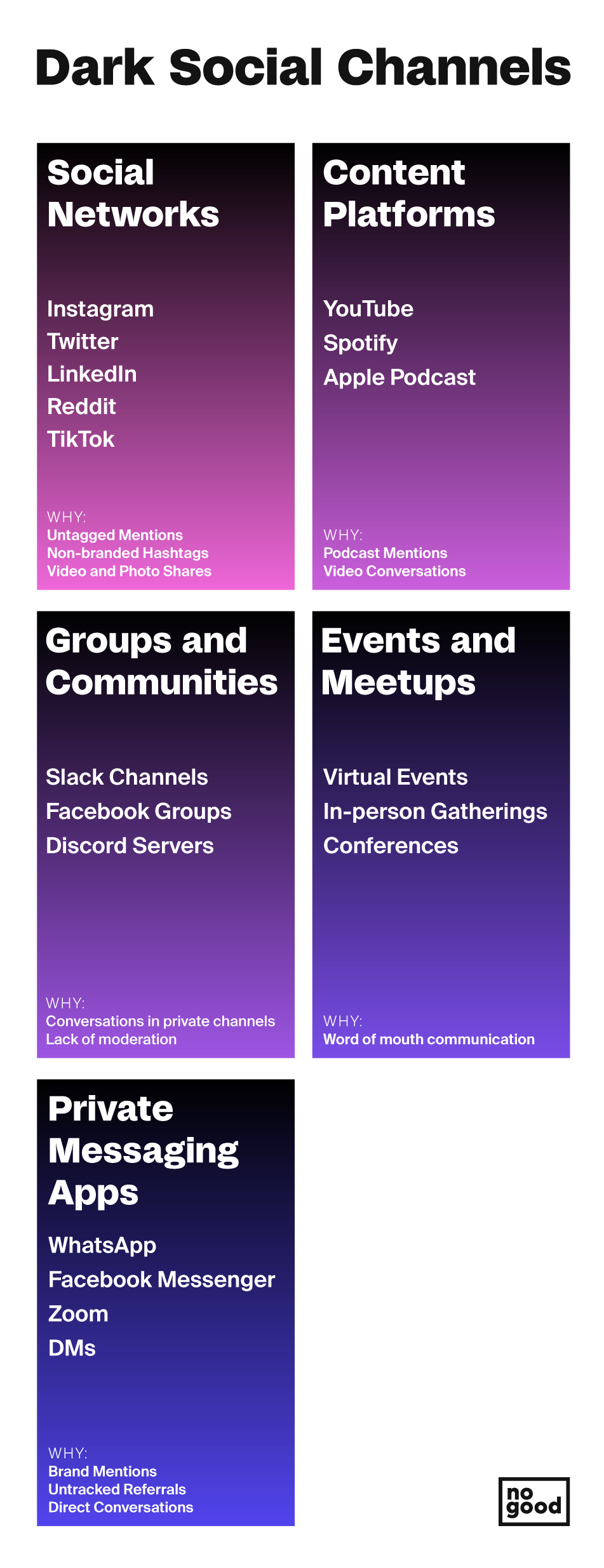Have you ever seen a piece of content, immediately thought of someone, and sent them the link in a Slack message, DM, or text? If you answered yes, then you’ve used Dark Social. While there are many misconceptions of what Dark Social is – it’s probably not what you may think.
What is Dark Social?
“Dark Social” is a term used to describe web traffic generated by social sharing channels that cannot be accurately tracked by traditional analytics platforms. These channels include social media, private messaging apps, and online communities. Other variations you may have heard include Dark Social Media, Dark Traffic, or Dark Funnel. AKA marketers are left in the dark without referral data.
Dark Social is dominating the social sharing space and is powered by community interaction. Beyond your known brand advocates, social media followers, and newsletter subscribers, there is a silent audience that can be just as powerful and integral to your marketing strategy.
It can be scary to enter a world of untracked data resulting in marketers being blind to nearly 80% of their social results – that’s a lot of users, traffic, and conversions unaccounted for! So how did we get here and how can we shed some light on Dark Social?
A Little History
Since the arrival of iOS 14, users have had the option to opt-out of tracking across apps, leaving marketers with little to no data on their audiences. Email and paid Facebook campaigns took a major hit in collecting conversion data, leaving marketers with lower match rates, dips in lookalike audience performance, and overall less information on audience demographics. In order to better target audiences and reach the right type of consumer, collecting user information is crucial to the success of any campaign, and while we are still navigating the drama of iOS 14 and beyond, Dark Social is resulting in even less user information.
Though it may be the latest marketing buzzword to populate your inbox, Dark Social has been talked about in marketing circles for over a decade after being first brought to light by Alexis Madrigal of The Atlantic. As our internet capabilities are getting smarter and more powerful, it seems our ability to collect user data used for ad targeting has dwindled.
As audiences aim to protect themselves even more, the reality of “living out loud” on public social media has turned inward as the rise of sharing via private channels has increased on platforms such as Slack, Facebook Groups, Discord, private group chats, and more. Users are becoming more cognizant of sharing their data and opting-out of tracking. Even more so, RhythmOne reported that 84% of sharing happens on Dark Social networks and only 16% is attributed to public social. Public social media has dwindled as users’ privacy concerns have grown.

How Dark Social Works
Are you used to seeing a Google Analytics acquisition graph that looks like this?

This is an example of a GA top channel user acquisition graph where direct traffic is dominating the other platforms. Direct traffic is typically categorized as users that type your URL into a browser or follow a browser bookmark. But are 45% of users really typing in your URL into a browser? If you’ve wondered this exact thought, keep reading because you may have a Dark Social challenge.
We all create content with the hopes of users engaging and sharing. For example, you create a killer infographic and share it on your company’s LinkedIn page. One of your followers engages with the content and shares it to their company’s Slack workspace. From there, a colleague goes to your website and signs up for your newsletter. But what was attributed to this referral? Was it Slack? Was it LinkedIn? No, it falls under Direct Traffic.
Now you’re probably thinking, I use UTMs, so I’m good.
If only it could be that simple…
Imagine your typical UTM. You may build yours differently than ours but they typically contain the following elements:

Due to UTM links, we know you arrived at our page because trackers were placed on the link. We can see you clicked on our link in our Instagram story that lead you to this page because we attached special tracking measures to it. But there is a large blindspot in tracking and we can see hundreds of viewers that haven’t been tracked. Somehow they just landed on this blog page and we have no idea where they came from. This is a dark spot in our tracking.
Typically, these user numbers appear in the “direct” category, meaning they typed in this exact link or bookmarked this page. But how many of you actually have this specific NoGood blog post bookmarked? Did someone text you this link or did you open it up from an email? Unless the link was a UTM, this occurrence will be labeled as “direct.” The unaccounted Dark Social channels that got you here also fall into this “direct” category.
To be clear, the difference is simple:
Did you type in https://nogood.io/2022/02/24/dark-social-the-silent-killer-of-social-tracking/
Or did you type in www.nogood.io and go on a journey to get to this blog article?
Both are considered direct traffic in this case.
Both are considered direct traffic in this case. But, did you click on this link from an email you received or see it shared on a colleague’s LinkedIn page? This attributes to Dark Social but would be reported as direct.
So if you were in the camp of thinking, “Well I always use UTMs, so Dark Social doesn’t apply to me,” you are living in the dark. Content can be shared with or without links through a simple copy and paste. Images and videos that live natively on your website or blog can be dragged and dropped into an instant message, Facebook page, or slack channel. In fact, 65-70% of website shares come from a copy and paste. When a UTM is copied and pasted, your UTM attribution is skewed because they cannot flexibly adapt. These c&p viewers end up floating around in Dark Social and never receive the correct attribution they deserve.
What Channels are Dark?

At NoGood, we preach and practice channel diversification. As marketers, we have all come so far becoming paid social experts using Facebook and Google, but after iOS 14, channel diversification became more important than ever to reach granular audiences based on interests and behaviors. By focusing on the paid side of these more familiar platforms, there are massive amounts of high intent traffic unaccounted for.
Reddit, TikTok, Instagram, Discord, Newsletters, and Slack channels are the new way to discover products. These semi-private channels will soon be infiltrated by marketers seeking impact and influence, but for now, they are a lot more reliable than Google because they are built on user trust. Users gravitate more towards community and bland algorithmic answers (even if good) still lack the trust that you can typically find in a community.
According to a study by Ogilvy Cannes, 74% of consumers consider word of mouth as a key influencer when making purchase decisions. This communication can be in-person, through social media, or private messaging. But when a product doesn’t get tagged or a URL tracked, it goes dark. Missing out on these “dark” users is particularly common in the B2B and SaaS categories. But the spaces where users are gathering have evolved and it’s become more crucial to meet them where they are at.
Let’s give channel diversification some more context. Marketers spend much of their time, energy, and budgets on paid search because of its simplicity of targeting, ability to track appropriately, and driven by high intent. But paid search isn’t the only way consumers discover your product. We need to take a step back and think about how people are really discovering and learning about your brand.
The Power of Dark Social
Though tracking can be a major concern for marketers married to GA, there is much power that lies within Dark Social and that is its authenticity. Dark Social is more personal due to the nature of how it is shared. We all want engagement on our content, but it is almost a higher compliment (and even better conversion) if the content gets shared privately. This reflects its genuine nature and quality of content that stirs a user’s behavior to specifically share with someone particular, not just pushing it out to their entire audience. In this way, these dark links develop more qualified leads and BOF conversions.
When a trusted person messages you a link, you are more likely to open it than if it came from a random stranger or email account. Especially when it comes to putting in your payment information or subscribing to an email list, a user is more likely to complete an action if a trusted source recommended it. This is the power of community-led growth in which Dark Social lives.
Community and Dark Social
On the surface, communities can be more easily formed around physical products such as workout enthusiasts joining Peloton communities or coffee lovers tagging Starbucks in their Instagram Stories. The pride around these brands and encouragement to use the hashtag #OnePeloton while getting in your stationary bike ride can seem much easier than a video at work using #Salesforce. But just because your brand doesn’t have a physical product to hold on to, doesn’t mean there isn’t a vibrant community already happening in Dark Social.
By brands building out their own community opportunities for users and enthusiasts, they can control the narrative of Dark Social and be privy to conversations about their products in ways they may not have been before. For example, Notion has private channels on Slack, Discord, and Facebook that are all moderated by community ambassadors known as Notion Pros. These are unpaid brand representatives that assist in answering Q&As, creating educational resources, and helping promote Notion globally.
Dedicated brand communities assist in taking control back of Dark Social by giving users a place to gather and communicate with other users, instead of talking about your product on an untraceable channel. Positive and negative feedback can be shared through these channels and community members and ambassadors can assist in answering questions and getting the pulse on what’s really being said.
Without dedicated communities, waiting for high intent metrics coming from paid search and social is often too late to make a brand impression when users are often learning about your brand way before it ever gets recorded. A user may come to you further down the funnel through their Dark Social community before they ever see an ad for your product. Brands can get ahead of their Dark Social problem by fostering communities that create safe and private spaces for users to interact and speak freely. When communities thrive, trust and loyalty build, and ad spend decreases when your community members are doing the marketing for you.
How can Dark Social be measured?
Say you are a social media manager who creates fire memes. The hope is that these memes go viral, leading people back to your site. But every time the meme is shared across varying public or private channels, its link changes just a little bit or doesn’t have a link at all (e.g. the meme gets screenshotted or copied and pasted). At the same time, your brand may be getting traffic because people saw your great meme, but you aren’t getting any of the credit, but direct is.
So how can this be measured and give credit where credit is due? How can we categorize these social attributions that are floating in a black hole of the internet?
1. Google Analytics
We’re all familiar with GA, but there is a way it can help you segment your Dark Social audience.
The goal is to separate direct traffic and bookmarks from Dark Social URLs. To do this, create an advanced segment and exclude specific URLs. Under “conditions,” type in landing pages that could potentially be bookmarked. For instance www.nogood.io/blog , /services, /about-us, etc.
Next, you’ll want to exclude “returning visitors” under “user type” because you want to focus on tracking unique visits to see what social media channels are actually working.
2. Pop-up and referral forms
Just as you would collect consumer data following a purchase, you can also add a “How did you hear about us?” field. If a user chooses from a pre-determined list or types in their answers, marketers can gain more insight into the exact attribution that got the customer to make a purchase. Was it your podcast, a post on LinkedIn, or a shared infographic? The results may surprise and inform your dark spots of attribution.
Tools like Responsely can be integrated into most websites and product pages to capture user feedback and increase sales.
3. Social buttons and referral programs
Though not always the most efficient, social buttons encourage sharing when well placed and designed. Though it can be cumbersome when a new web page is opened or your login information is requested, creating an easy way to share can assist in tagging users correctly when the button is attached to a tracking link. This can be done for private messaging and public social sharing.
Many of our favorite newsletters include easy social sharing. The Morning/Marketing Brew newsletters include custom codes provided by platforms such as SparkLoop to track users’ referrals and reward them for doing such.
4. Tracking tools and social media Listening
Social Listening goes beyond tracking mentions and analyzes social data for conversations about your brand and in your industry to better suggest insights for marketing decisions. Sprinklr uses AI-powered social listening to turn unstructured data and turn them into actionable insights.
Tools such as GetSocial, AddThis, and ShareThis, all claim to assist in tracking Dark Social. Though it may not always be foolproof they do offer more visibility into the social shares you may be missing. We also can’t recommend setting up Google Alerts for your brand enough! These forward any mentions of chosen keywords across the internet direct to your inbox.
5. Link shorteners
Giant UTM links can be cumbersome and visually unattractive on social media posts. Link shorteners such as Bitly or Owly can shorten your links and their platforms provide tracking analytics and customizable options.
Many social media managers also recommend link landing pages such as Linktree, Lnk.Bio, or Linkin.io by Later. These are great for leading users to one place where all your links are congregated and easy to navigate between. UTM links can be attached or you can use their automatic UTM parameters to track where users came from, CTRs, and more.
Leaning into the Dark
Though we can’t 100% track Dark Social, it is still working hard as seen by the large direct traffic attribution channel. This is why brands are leaning into these channels instead of relying on traditional paid social and paid search. In these strategies, marketers wait for the consumers to come to them. Though these channels have high intent, they do not create demand.
Marketers who rely too much on these automations are largely limiting themselves from reaching audiences and communities who may be arriving with pre-disposed intent vs. coming only after viewing paid TOF or BOF campaigns.
Instead, find where your buyers are hanging out and meet them there. Though these may be dark channels, they are a place to educate and reach prospective customers instead of waiting for them to come to you. Create a safe place for users to gather and communicate where they want to share and learn from one another. Though Dark Social is more difficult to measure, it will pay off in the long run when you are the consumers’ brand of choice and your community begins to provide leads, feedback, and conversions of its own.
Yes, we at NoGood are obsessed with data, automation, and attribution, but the time has come to step into the light (or in this case, the dark). By embracing the dark side of social, we are encouraging users to engage and share our content and not be afraid of it being untraceable.
Continue being a data-driven marketer, but don’t be afraid to go places where data can’t be tracked. You don’t want to miss out on these important touchpoints in the buyer journey even if it is in the dark.





